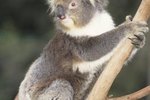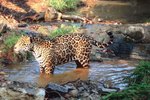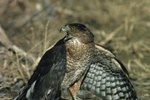
Wildlife is ample in the natural rain forest of Iguazu Falls. It's located on the border of Argentina and Brazil. The Iguazu River has the most fascinating waterfalls in the world, 270 to be exact. Animal, plant life and vegetation are abundant at Iguazu Falls. More than 2,000 species of plants and animals call this lush rain forest home.
Native Toucans

Toucans are native to subtropical and tropical regions. Their large bright-colored bills cause them to stand out among other birds. They have compact bodies and an average adult grows to 7 to 11 inches. Their diet consists of insects, fruit and lizards. Their main protein source comes from consuming nestlings of other bird species. Toucans provide an ecological role by dispersing the seeds of fruit trees throughout the rain forest.
Jaguar Haunt

Jaguars are the third largest feline after the lion and tiger. Ninety percent of the species has spots similar to a leopard, while the remaining 10 percent are black. They are attracted to water sources and are known to enjoy swimming in lakes, rivers and streams. A dense rain forest is the jaguar's preferred habitat. The jaguar has a powerful bit capable of piercing through turtle shells. It feeds only on meat, frequently consuming monkeys, fish, sloths, turtles, mice, birds, frogs, dogs, foxes, deer, tapirs and caimans.
Capybara Haven

The largest rodent in the world, the capybara, prefers a habitat of dense forestry and bodies of water. They live in social groups ranging from 20 to 100. Adults grow to about 20 inches tall and 4 feet in length, with brown-reddish fur. They feed on grass, tree bark, plants and fruit. Consuming their own feces provides them with a source of bacterial gut floral that aids in digestion. Although they can live up to 10 years in the wild, they are prey to many predators. Their predators include anacondas, ocelots, jaguars, pumas, caimans and eagles.
Howler Monkey

Red, black or tan adult howler monkeys are large, reaching about 36 inches, excluding the tail. Their tails are long, at times reaching up to 5 feet, they are used in a variety of ways, including as a tool for food and to travel between trees. Their life span reaches up to 20 years. Their loud howls bring them attention in the rain forest. A howler monkey's diet consists of fruit, flowers, nuts, buds, canopy leaves and bird eggs. They are slow moving and are capable of traveling through dense forest among the tops of branches for miles.
References
Resources
Photo Credits
-
Ryan McVay/Photodisc/Getty Images
Writer Bio
Based in Miami, Shellie Alyssa has been writing articles since 2011. Her articles have appeared on a variety of popular and informative pet websites including munch.zone. In 2000, she was awarded an editors choice award for Outstanding Achievement in Poetry from the International Library of Poetry. She holds a fashion merchandising diploma from Penn Foster College.




